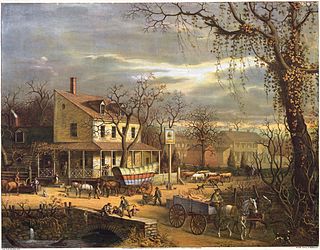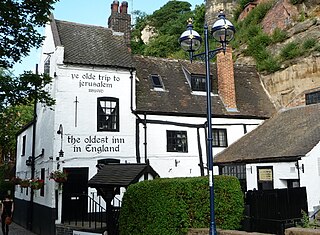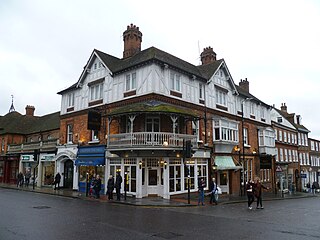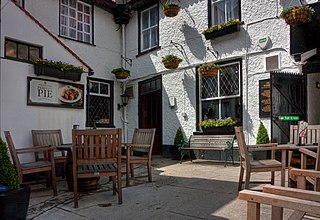
Inns are generally establishments or buildings where travelers can seek lodging, and usually, food and drink. Inns are typically located in the country or along a highway. Before the advent of motorized transportation, they also provided accommodation for horses.

A pub is a drinking establishment licensed to serve alcoholic drinks for consumption on the premises. The term first appeared in the late 17th century, and was used to differentiate private houses from those which were open to the public as alehouses, taverns and inns. Today, there is no strict definition, but CAMRA states a pub has four characteristics:
- is open to the public without membership or residency
- serves draught beer or cider without requiring food be consumed
- has at least one indoor area not laid out for meals
- allows drinks to be bought at a bar

The London Borough of Barnet is a suburban London borough in North West London. The borough was formed in 1965 from parts of the ceremonial counties of Middlesex and Hertfordshire. It forms part of Outer London and is the second largest London borough by population with 389,344 inhabitants, also making it the 17th largest district in England. The borough covers an area of 86.74 square kilometres (33 sq mi), the fourth highest of the 32 London boroughs, and has a population density of 45.8 people per hectare, which ranks it 25th.

Chipping Barnet or High Barnet is a suburban market town in north London, forming part of the London Borough of Barnet, England. It is a suburban development built around a 12th-century settlement, and is located 10+1⁄2 miles (17 km) north-northwest of Charing Cross, 3 miles (4.8 km) east from Borehamwood, 5.2 miles (8.4 km) west from Enfield and 3.2 miles (5.1 km) south from Potters Bar. Its population, including its localities East Barnet, New Barnet, Hadley Wood, Monken Hadley, Cockfosters and Arkley, was 47,359 in 2011.

Buntingford is a market town and civil parish in the district of East Hertfordshire and county of Hertfordshire in England. It lies next to the River Rib and is located on the historic Roman road, Ermine Street. As a result of its location, it grew mainly as a staging post with many coaching inns and has an 18th-century one-cell prison known as The Cage, by the ford at the end of Church Street. It has a population of 7879, as of the 2021 UK Census.

Pub names are used to identify and differentiate traditional drinking establishments. Many pubs are centuries old, and were named at a time when most of their customers were illiterate, but could recognise pub signs. The use of signage was not confined to drinking establishments. British pubs may be named after and depict anything from everyday objects, to sovereigns, aristocrats and landowners. Other names come from historic events, livery companies, occupations, sports, and craftsmen's guilds. One of the most common pub names is the Red Lion. This list contains both modern and historical examples.

Ye Olde Fighting Cocks is a public house in St Albans, Hertfordshire, England. It is one of several pubs that lay claim to being the oldest in England, claiming to have been in business since 793 AD. The pub was once recognized as the oldest in England by the Guinness World Records, but this title was wrested in 2000. The building is described by Historic England as being of 16th-century appearance, but as the earliest date for which it can be proved to have been licensed is 1756, and even that date is not certain, its claim to this record is somewhat uncertain. Others such as the Ye Olde Man & Scythe in Bolton, Greater Manchester, and Ye Olde Trip to Jerusalem in Nottingham may have better claims. Even in St Albans, the White Hart and the Fleur de Lys are believed to have been trading as inns in the late medieval period.

Ye Olde Trip to Jerusalem is a Grade II listed public house in Nottingham which claims to have been established in 1189, although there is no documentation to verify this date. The building rests against Castle Rock, upon which Nottingham Castle is built, and is attached to several caves, carved out of the soft sandstone. These were reputedly originally used as a brewhouse for the castle, dating from the medieval period.

Barnet was a local government district in south Hertfordshire from 1863 to 1965 around the town of Barnet.

East Barnet Valley was a local government district from 1863 to 1965 around the town of East Barnet. It was partly in the counties of Hertfordshire and Middlesex until 1889, when the Middlesex part was transferred to Hertfordshire. It was renamed East Barnet in 1935.

The Ye Olde Mitre is a Grade II listed public house at 1 Ely Court, Ely Place, Holborn, London EC1N 6SJ.

Ye Olde Dolphin Inne is a Grade II listed pub, on Queen Street, in the city of Derby, England.

St John the Baptist Church is the Church of England parish church of Chipping Barnet, Greater London. It forms part of the Chipping Barnet Team Ministry, comprising St Mark's, Barnet Vale, St Peter's, Arkley and St Stephen's, Bell's Hill. It crowns the ascent up Barnet Hill, and stands at the junction of Wood Street and High Street. It is one of the few Anglican churches in Greater London to belong to the Diocese of St Albans.

The Red Lion is a grade II listed public house in the High Street, Chipping Barnet, London.

The Peahen is a public house in St Albans, Hertfordshire, England. The pub has been managed by McMullens Brewery since 1936.

The Swan with Two Necks was a coaching inn in the City of London that, until the arrival of the railways, was one of the principal departure points for travel to the north of England from London. Its site was given over in the early 1860s to a goods and parcels depot for a firm of railway agents and carriers.

The Bull and Mouth Inn was a coaching inn in the City of London that dated from before the Great Fire of London in 1666. It was located between Bull and Mouth Street in the north and Angel Street in the south. It was once an important arrival and departure point for coaches from all over Britain, but particularly for the north of England and Scotland. It became the Queen's Hotel in 1830 but was demolished in 1887 or 1888 when new post office buildings were built in St Martin's Le Grand.

Ye Olde Starre Inne is a pub in the city centre of York, in England. The main block of the pub is a timber-framed structure, constructed in the mid-16th century, and a wing to its left was added in about 1600. By 1644, it was an inn named "The Starre", the buildings lying at the back of a coaching yard, off the north side of Stonegate. This makes it the pub in York which can demonstrate the earliest date for its licence. After the Battle of Marston Moor the inn was used as a hospital for wounded soldiers.

Barnet Common was an area of common land to the south of the town of Chipping Barnet in what is now north London. The Common was created after a wood was cleared in the 16th century and was mostly used by local people to graze their animals. It was the location of a Digger colony and of the Barnet Physic Well at which mineral water was consumed. Part of the Common was enclosed in 1729 and the rest in 1815, leading to development on the north and south sides, and later infilling.


























